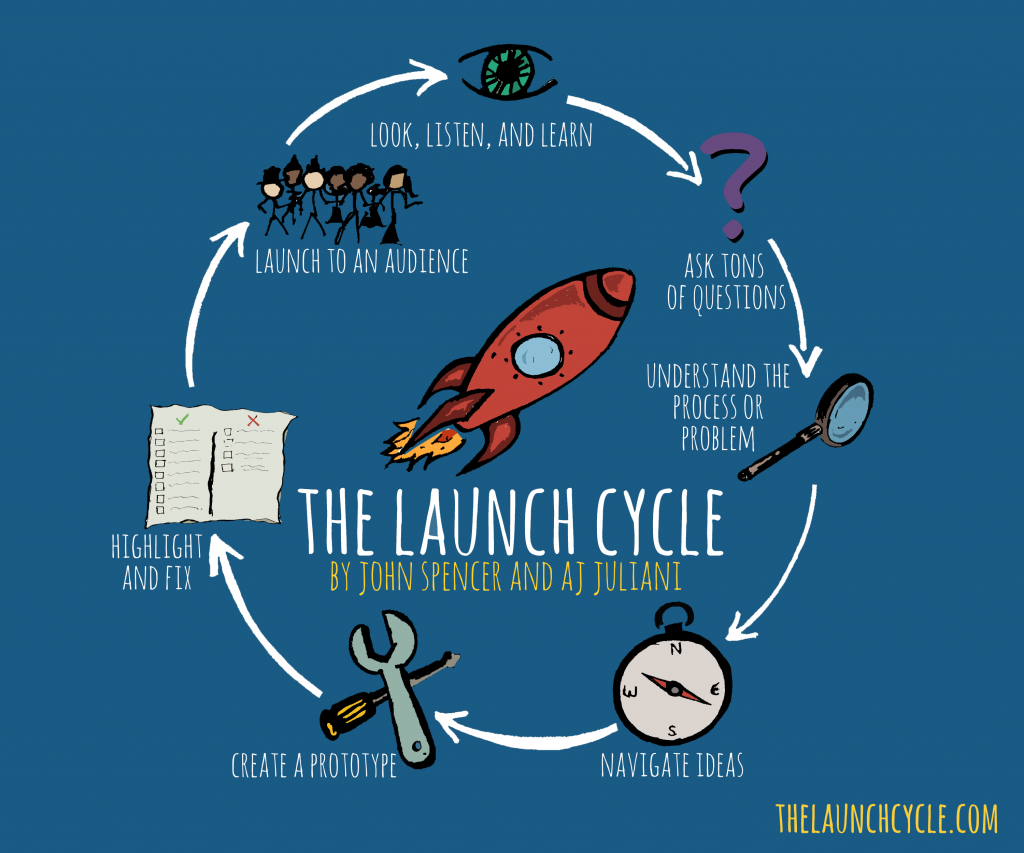

Design thinking can unleash creativity for students in all types of classes and at all ages. Here are some ideas to get you started. (Image via thelaunchcycle.com)
It’s well documented that the world is moving away from routine, repetitive, low cognitive capacity jobs.
The “four C’s” — critical thinking, communication, collaboration and creativity — are on the rise.
Instead of being told what to do, workers will need to do more brainstorming, more creating, more problem solving.
What better way to learn that than by making something?
That’s what design thinking is all about. John Spencer and A.J. Juliani define design thinking in the book LAUNCH: Using Design Thinking to Boost Creativity and Bring Out the Maker in Every Student. They say …
Design thinking isn’t a subject, topic or class. It’s more a way of solving problems that encourages positive risk-taking and creativity.
I like to think of it as identifying a problem and solving that problem by making something.

The LAUNCH Cycle, by John Spencer and A.J. Juliani. (via thelaunchcycle.com)
The book LAUNCH is a blueprint for bringing this kind of thinking into the classroom. It walks you through a framework that students can follow for creating something meaningful that solves a problem.
And it’s all done in pursuit of standards and your curriculum.
(For those that are fascinated by this and want to learn more about design thinking, John Spencer has a great online course called “Design Thinking for Teachers.” It includes tons of video lessons, an ebook called “Getting Started with Design Thinking,” a private Facebook group and more. It’s basically like having 24-7 access to John himself! If you’re interested, check out the online course here.)
Here are some of the key ideas I’ve gained from reading the book and from John’s online course:
1. Creativity is a process that requires structure. I’ve learned this the hard way in my own class. I’ve tried to “turn students loose” and let them display their creativity in a very unstructured setting. Instead of liberating them, it paralyzed them. “Structure provides the outline for a song, the dimensions for an architectural wonder, and the steps for a successful launch into space,” John and A.J. write. Their LAUNCH framework is a great structure for creative work.
2. Everyone has his/her own approach to creativity. Not everyone can grab a blank canvas and paint a masterpiece on the fly. Not everyone can craft the lyrics to a great song. Everyone is different, and teachers are no exception. John and A.J. spell out several creative mindsets of teachers, including:
Which one do you most relate to?
3. Certain circumstances help design thinking flourish. Creating a product from scratch takes a long time. So does following a big idea through to completion. Because design thinking can be long-term work, certain things help it succeed. John and A.J. suggest giving students time to go through the whole creative process. They also suggest helping students find a problem that’s important to them (rather than imposing a problem on them).
4. Build awareness. The best way to solve a problem is to understand it fully first. When embarking on the design thinking process, students need the time and resources necessary to build that awareness. Who are they serving? What needs do they feel? What’s their life like? John and A.J. say finding a group students can empathize with or identifying a problem they’d like to solve can be the first step.
5. Questions are crucial. “Sometimes, the bravest thing you can do is ask a question,” John and A.J. write in LAUNCH. They say it’s important to get as many questions out in the open as possible. Some ways to do that:
6. Find and understand answers. This seems obvious, and it’s something we’ve done forever in schools. But when it comes to research, we should revisit our definition of it, John and A.J. write. John tells the story of catching himself telling a student to get back to his “real research,” what he was assigned to do in class. But research takes many forms. It can be pursuing your own questions. It can be asking someone else. We should be careful not to fall into the “rigid research trap,” as they call it.
7. Plan first. Once you have answers, it’s easy to jump in and start creating, John and A.J. write. But creating a solid plan gives students a roadmap and helps them arrive at the right destination. Plus, the deep thinking done to create a well crafted plan is an important step in the process. (John talks about the brainstorming process in this “sketchy video” he created.)
8. Go make something! This is what everyone has been waiting for. It’s the most exciting part of design thinking — at least at first, John and A.J. write. Then comes “project fatigue,” when working to completion or overcoming problems can kill their enthusiasm. “You will have at least one ‘Houston, we have a problem’ moment,” they write. But, they write, “Every roadblock is a chance to solve a problem.”
9. Make it the best you can. After making, John and A.J. suggest two next steps: highlighting what works well and improving what doesn’t work well. But sometimes, students don’t always want to do revisions. They’re ready to be done. There’s a lot teachers can do to keep the revision process interesting, they write. Sharing stories of great products and ideas that took tons of revisions can motivate, as can a simple change in student grouping and peer conferencing.
10. Launch it! At this point in the process, it’s time to launch. John and A.J. write:
This is the phase where students send what they’ve created to an authentic audience. However, great products do not end up in the hands of the intended audience on their own.
To pull off a great launch, it’s important to:
So, why is this design thinking concept so important in schools? John and A.J. spell that out in their “We believe …” section at the beginning of the book:
We believe that creative thinking is as vital as math or reading or writing. There’s power in problem-solving and experimenting and taking things from questions to ideas to authentic products that you launch into the world.
And if that’s what students will likely do in the future — and it’s a lot of fun — why not try it?
For more information about design thinking in the classroom, check out:
For notifications of new Ditch That Textbook content and helpful links:
Interested in having Matt present at your event or school? Contact him by e-mail!
Matt is scheduled to present at the following upcoming events:
[getnoticed-event-table scope=”upcoming” max=”15″ expanding=”false”]
Session expired
Please log in again. The login page will open in a new tab. After logging in you can close it and return to this page.
We all have our own definition of creativity. And if your own creativity does not meet the creativity of the person next to you, respect them as much as possible. These ideas will make you appreciate the art of designing and how you can do better with it.